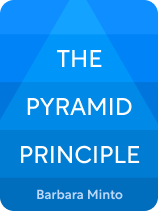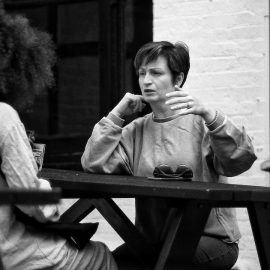

This article is an excerpt from the Shortform book guide to "The Pyramid Principle" by Barbara Minto. Shortform has the world's best summaries and analyses of books you should be reading.
Like this article? Sign up for a free trial here.
What makes a good introduction paragraph? How can you engage with your audience in your first paragraph?
The introduction determines whether readers will continue to read your piece. According to Barbara Minto in her book The Pyramid Principle, a good introduction paragraph intrigues readers in just 30 seconds.
Keep reading to learn how to write the best introduction paragraph anyone has ever read.
Writing a Clear, Engaging Introduction Paragraph
According to Minto, your piece should begin with a clear, good introduction paragraph so that your reader understands your conclusions within the first 30 seconds of reading. Minto argues that doing this is polite: By providing your readers with a brief preview of your piece, you’re giving them the information they need to determine whether they should keep reading. For instance, imagine someone reading your composting email already believes she should compost. Once she reads your introduction, she’ll realize within the first 30 seconds that you agree; and from there, she may decide there’s no use reading a piece she already agrees with.
(Shortform note: How much can someone read in 30 seconds? Researchers estimate that adults’ average silent reading rate (the rate for reading in their heads) is 238 words per minute. An introduction that someone can read in 30 seconds should be close to half of that length: about 120 words. Most five-sentence paragraphs are close to that length. To respect your reader’s time, aim to explain your conclusions within a paragraph like this.)
Furthermore, Minto argues that you can make your introduction engaging by structuring it like a fictional story. Fictional stories typically have three parts: a beginning that sets the scene, a middle that introduces a problem, and an ending that resolves the problem. According to Minto, this structure works well for nonfiction introductions as well because it smoothly eases your reader toward your Peak Conclusion.
(Shortform note: Minto’s recommendation to enhance your introduction with techniques from fiction can be extended to other areas of your nonfiction piece as well. For example, you might apply the fiction-writing technique of building suspense to the title of your nonfiction piece. Fiction writers create suspense by leaving information out of their writing. Doing so plants questions in the reader’s mind and leaves them eager to discover the answers—so, they read on. To create suspense in your nonfiction piece’s title, drop a hint that there’s a problem without revealing the entire problem. Many of the most-read news articles feature suspenseful headlines that hint at a problem, such as “This is Why Uma Thurman is Angry.”)
Let’s explore how to craft a fiction-inspired introduction that features a beginning, middle, and end.
Introduction Element 1: The Beginning
According to Minto, the beginning of your introduction provides the reader with context for your topic. She claims that people tend to be receptive to new ideas they might disagree with if you first provide them with a familiar context. To do this, provide a “where” and “when” that together establish a context that the reader will recognize and relate to. For example: “As you may have heard, our city is starting a new composting program next month.”
(Shortform note: How can you write a beginning sentence that establishes context and captures the reader’s attention? One writer recommends that you breathe life into your nonfiction writing by borrowing techniques from poetry. For instance, you can establish a context for an essay using a blazon: a list of descriptions that paint a picture of your “where” and “when.” Ta-Nehisi Coates’s well-known article “The Case for Reparations” provides an example of how to establish context with a blazon: “Two hundred fifty years of slavery. Ninety years of Jim Crow. Sixty years of separate but equal. Thirty-five years of racist housing policy. Until we reckon with our compounding moral debts, America will never be whole.”)
Introduction Element 2: The Middle
Minto explains that the introduction paragraph’s middle is where you share the question you brainstormed earlier (to which your Peak Conclusion is the answer or solution). The role of the middle is to pique your reader’s curiosity, compelling them to read on. You could phrase the middle as a question: “Should you compost?” Alternatively, you could phrase the middle as a problem: “I’ve heard many of you are unsure whether you should participate in the city’s composting program.”
(Shortform note: Research supports Minto’s claim that raising a question or problem compels your reader to continue reading. Psychologists claim that when we encounter an unfinished task in the form of a problem or question, we experience the Zeigarnik effect: We can’t stop thinking about that unfinished task, and we crave the relief of discovering how it resolves. Cliffhangers in books, movies, and TV use this effect to keep audiences hooked during breaks from the story.)
Introduction Element 3: The End
Finally, Minto claims that you should end your introduction paragraph by stating your Peak Conclusion and your Tier 1 conclusions. Sharing your Tier 1 conclusions provides the reader with a roadmap of what’s ahead, which improves the clarity of your piece. You can share your Peak Conclusion and Tier 1 conclusions in separate sentences, or you can combine them into a single sentence. This example does the latter: “I strongly encourage you to consider participating in the city’s composting program because it benefits both you and the community.”
(Shortform note: Starting your piece with context (in the form of the beginning and middle) before sharing your Peak Conclusion seems to contradict the premise of conclusions-first writing. However, we can infer from Minto’s recommendations for writing an introduction that your reader needs this context in order to comprehend your Peak Conclusion. Arguably, a piece of writing that begins with an introduction like this is still conclusions-first because you share the conclusions before you fully explore the Tier 1 ideas that support them.)

———End of Preview———
Like what you just read? Read the rest of the world's best book summary and analysis of Barbara Minto's "The Pyramid Principle" at Shortform.
Here's what you'll find in our full The Pyramid Principle summary:
- How to write so clearly that you can get a point across within 30 seconds
- How to write a clear, compelling introduction, body, and conclusion
- Why you should always start your prose with your conclusion and work backward






